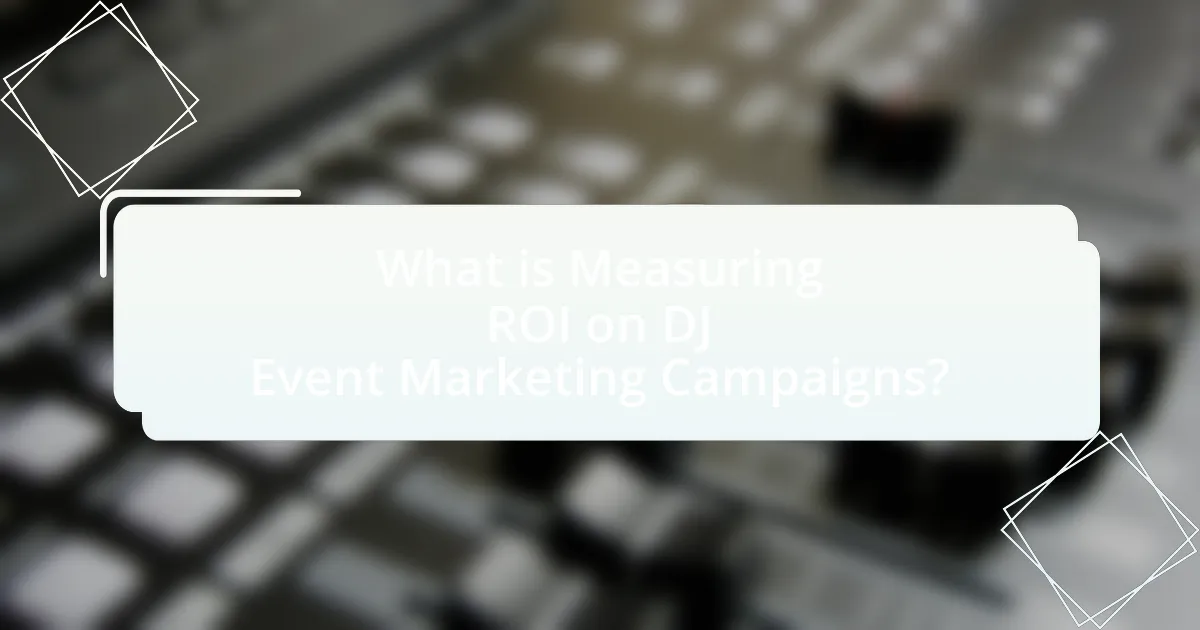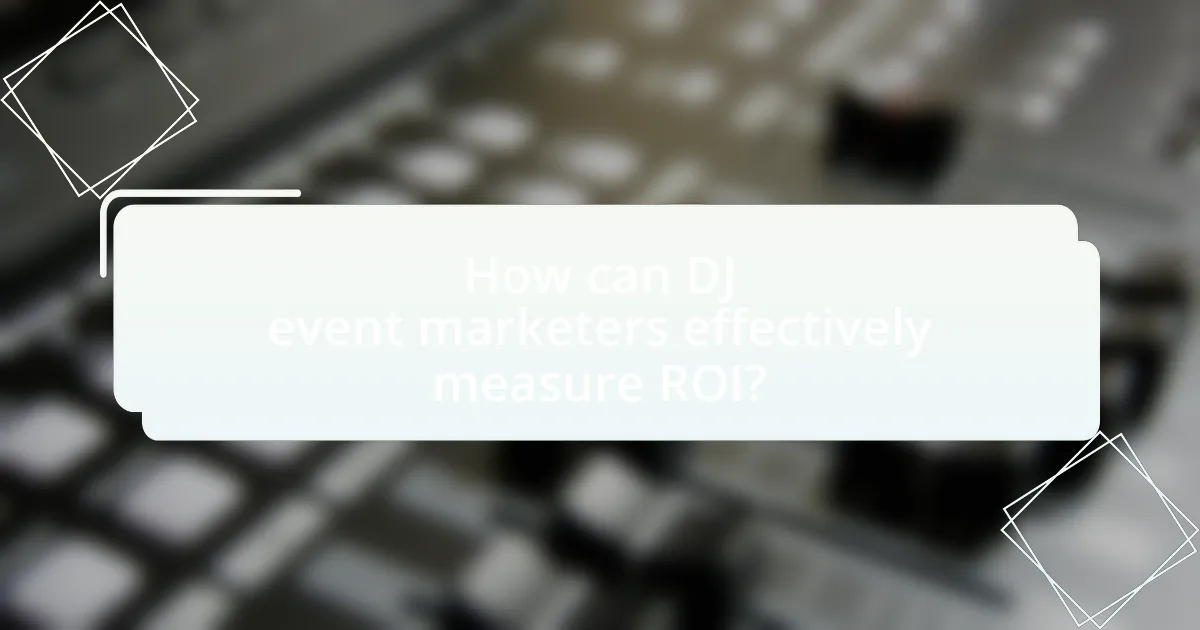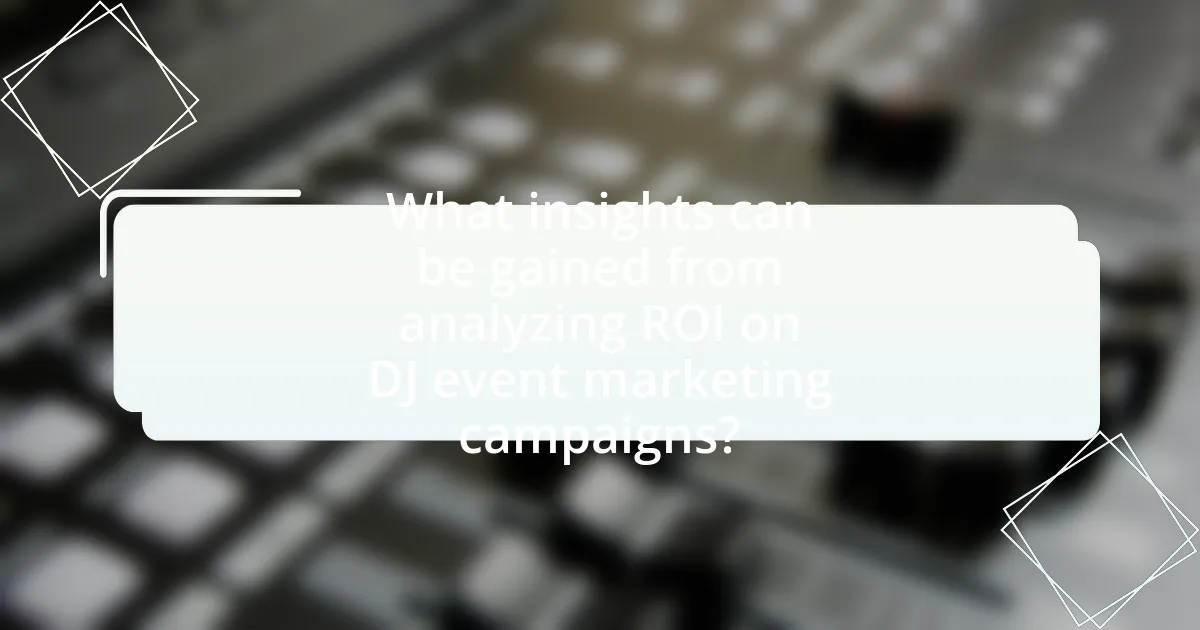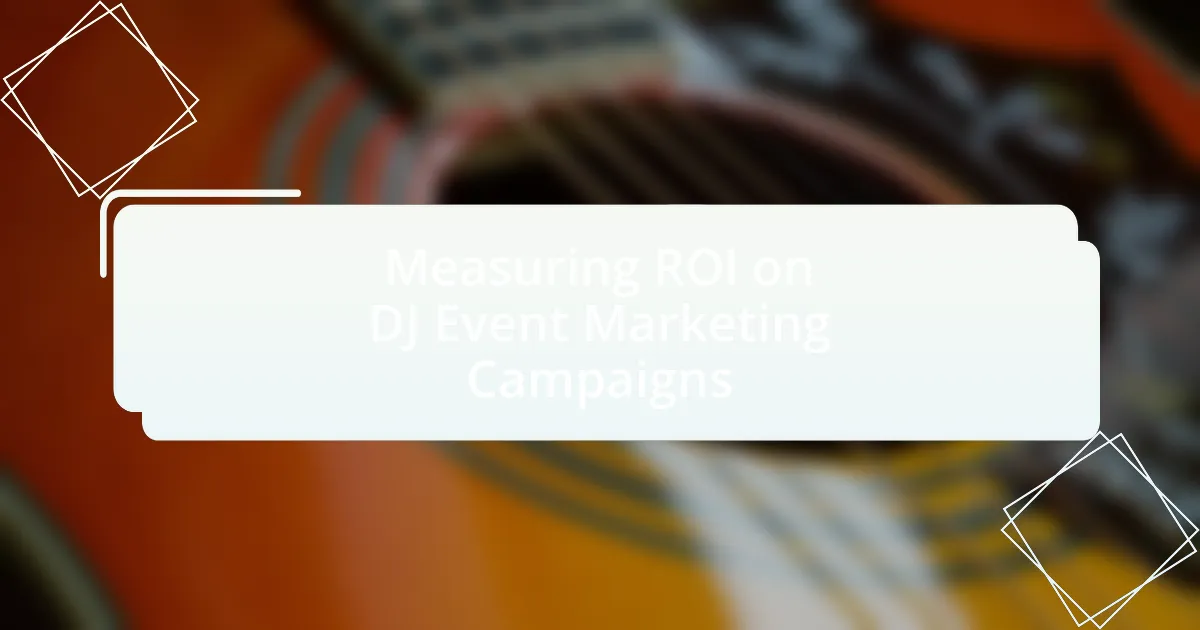Measuring ROI on DJ event marketing campaigns is a critical process that evaluates the financial return generated from marketing efforts specific to DJ events. This article outlines the definition of ROI in this context, the metrics used for calculation, and the importance of ROI in assessing marketing success. It also discusses the key components of DJ event marketing campaigns, the impact of promotional strategies and audience engagement on ROI, and the challenges faced in measuring ROI. Additionally, the article highlights best practices for data analysis, tools for measuring ROI, and strategies for maximizing returns in future campaigns. Insights gained from ROI analysis can inform future marketing strategies and improve event planning, ultimately leading to enhanced profitability in DJ events.

What is Measuring ROI on DJ Event Marketing Campaigns?
Measuring ROI on DJ event marketing campaigns involves calculating the return on investment generated from marketing efforts specific to DJ events. This process typically includes assessing the revenue generated from ticket sales, merchandise, and sponsorships against the costs incurred for marketing activities such as advertising, promotions, and event production. For instance, if a DJ event generates $10,000 in revenue and the marketing costs total $2,000, the ROI can be calculated as (Revenue – Costs) / Costs, resulting in an ROI of 400%. This metric helps DJs and event organizers evaluate the effectiveness of their marketing strategies and make informed decisions for future campaigns.
How is ROI defined in the context of DJ event marketing?
ROI, or Return on Investment, in the context of DJ event marketing is defined as the ratio of net profit generated from an event to the total costs incurred in organizing and promoting that event. This metric allows event organizers to evaluate the financial effectiveness of their marketing strategies by comparing the revenue generated from ticket sales, sponsorships, and merchandise against the expenses of venue rental, marketing campaigns, and artist fees. For instance, if a DJ event costs $10,000 to produce and generates $15,000 in revenue, the ROI would be calculated as ($15,000 – $10,000) / $10,000, resulting in a 50% return on investment. This quantifiable measure helps in assessing the success of marketing efforts and guiding future event planning decisions.
What metrics are used to calculate ROI for DJ events?
The metrics used to calculate ROI for DJ events include total revenue generated, total costs incurred, and the number of attendees. Total revenue encompasses ticket sales, merchandise sales, and sponsorship income, while total costs cover venue rental, equipment, marketing expenses, and artist fees. The ROI is calculated using the formula: (Total Revenue – Total Costs) / Total Costs. This formula provides a clear financial picture of the event’s profitability, allowing for effective assessment of marketing campaign success.
Why is ROI important for evaluating DJ event marketing success?
ROI is important for evaluating DJ event marketing success because it quantifies the financial return generated from marketing investments relative to their costs. By calculating ROI, DJs and event organizers can assess the effectiveness of their marketing strategies, enabling them to make informed decisions about future campaigns. For instance, a study by the Event Marketing Institute found that events with a clear ROI measurement strategy reported 20% higher satisfaction rates among stakeholders. This demonstrates that understanding ROI not only helps in optimizing marketing efforts but also enhances overall event performance.
What are the key components of DJ event marketing campaigns?
The key components of DJ event marketing campaigns include target audience identification, promotional strategies, partnerships, and performance metrics. Target audience identification involves understanding the demographics and preferences of potential attendees to tailor marketing efforts effectively. Promotional strategies encompass social media marketing, email campaigns, and influencer collaborations to generate buzz and drive ticket sales. Partnerships with local businesses or brands can enhance visibility and provide additional resources for the event. Finally, performance metrics such as ticket sales, social media engagement, and attendee feedback are crucial for measuring the success of the campaign and informing future marketing efforts.
How do promotional strategies impact ROI?
Promotional strategies significantly impact ROI by directly influencing customer engagement and sales conversion rates. Effective promotional tactics, such as targeted advertising and social media campaigns, can lead to increased attendance at DJ events, which in turn boosts ticket sales and overall revenue. For instance, a study by the Event Marketing Institute found that 70% of attendees reported being influenced by promotional efforts when deciding to attend an event. This correlation demonstrates that well-executed promotional strategies can enhance brand visibility and customer interest, ultimately resulting in a higher return on investment for marketing expenditures.
What role does audience engagement play in measuring ROI?
Audience engagement is crucial in measuring ROI as it directly correlates with the effectiveness of marketing efforts and the financial returns generated from those efforts. High levels of audience engagement indicate that the marketing campaign resonates with the target demographic, leading to increased ticket sales, merchandise purchases, and overall event attendance. For instance, a study by Eventbrite found that events with higher engagement rates saw a 20% increase in ticket sales compared to those with lower engagement. This demonstrates that tracking metrics such as social media interactions, email open rates, and attendee feedback can provide valuable insights into the financial impact of marketing strategies, ultimately allowing for a more accurate assessment of ROI.
What challenges are faced when measuring ROI on DJ event marketing?
Measuring ROI on DJ event marketing faces several challenges, primarily due to the difficulty in quantifying intangible benefits and the lack of standardized metrics. Intangible benefits, such as brand awareness and customer loyalty, are hard to measure directly, making it challenging to assess their financial impact. Additionally, the absence of consistent metrics across different events complicates comparisons and evaluations. For instance, while ticket sales provide a clear revenue figure, other factors like social media engagement or audience satisfaction do not translate easily into monetary terms. Furthermore, external variables, such as market trends and competition, can influence outcomes, making it difficult to attribute success solely to marketing efforts. These complexities hinder accurate ROI calculations and decision-making for future marketing strategies.
How can data collection methods affect ROI analysis?
Data collection methods significantly impact ROI analysis by determining the accuracy and relevance of the data used to evaluate marketing effectiveness. For instance, quantitative methods like surveys and sales data provide measurable insights into customer behavior and financial outcomes, while qualitative methods such as interviews can reveal deeper motivations but may lack generalizability. The choice of method influences the quality of data, which in turn affects the reliability of ROI calculations. Research indicates that businesses employing mixed-method approaches often achieve more comprehensive insights, leading to more informed decision-making regarding marketing strategies.
What common pitfalls should be avoided in ROI measurement?
Common pitfalls to avoid in ROI measurement include neglecting to define clear objectives, failing to account for all costs, and not using consistent metrics. Defining clear objectives ensures that the ROI measurement aligns with specific goals, while accounting for all costs, including indirect expenses, provides a more accurate picture of profitability. Using consistent metrics allows for reliable comparisons over time and across different campaigns. According to a study by the American Marketing Association, organizations that clearly define their objectives and metrics see a 30% improvement in their ROI measurement accuracy.

How can DJ event marketers effectively measure ROI?
DJ event marketers can effectively measure ROI by analyzing key performance indicators (KPIs) such as ticket sales, attendee engagement, and social media reach. By tracking the revenue generated from ticket sales against the total marketing expenses, marketers can calculate the ROI percentage. For instance, if a DJ event generates $10,000 in ticket sales with $2,000 spent on marketing, the ROI would be 400%. Additionally, using tools like Google Analytics to assess website traffic and conversion rates can provide insights into the effectiveness of marketing strategies. This data-driven approach allows marketers to make informed decisions and optimize future campaigns based on measurable outcomes.
What tools and technologies are available for measuring ROI?
Tools and technologies available for measuring ROI include analytics software, customer relationship management (CRM) systems, and marketing automation platforms. Analytics software, such as Google Analytics, allows event marketers to track website traffic and conversion rates, providing insights into the effectiveness of marketing campaigns. CRM systems, like Salesforce, help in tracking customer interactions and sales data, enabling marketers to assess the financial impact of their campaigns. Marketing automation platforms, such as HubSpot, facilitate the measurement of campaign performance through metrics like lead generation and customer engagement. These tools collectively enable marketers to quantify the return on investment by linking marketing efforts to revenue outcomes.
How do analytics platforms enhance ROI tracking?
Analytics platforms enhance ROI tracking by providing real-time data analysis and performance metrics that allow businesses to assess the effectiveness of their marketing campaigns. These platforms aggregate data from various sources, such as social media, email marketing, and website traffic, enabling a comprehensive view of customer engagement and conversion rates. For instance, a study by HubSpot found that companies using analytics tools experienced a 20% increase in ROI due to improved targeting and campaign optimization. By leveraging these insights, businesses can make data-driven decisions, allocate resources more efficiently, and ultimately increase their return on investment in DJ event marketing campaigns.
What role does social media play in measuring event marketing ROI?
Social media plays a crucial role in measuring event marketing ROI by providing real-time data on audience engagement and reach. Platforms like Facebook, Instagram, and Twitter allow marketers to track metrics such as likes, shares, comments, and event check-ins, which directly correlate to attendee interest and participation. For instance, a study by Eventbrite found that events promoted on social media saw a 20% increase in attendance compared to those that were not. This data enables marketers to analyze the effectiveness of their campaigns, adjust strategies accordingly, and ultimately calculate the return on investment based on increased ticket sales and brand visibility.
What strategies can improve ROI measurement accuracy?
To improve ROI measurement accuracy in DJ event marketing campaigns, implementing a multi-channel tracking system is essential. This system allows marketers to capture data from various sources, such as social media, email campaigns, and ticket sales, providing a comprehensive view of customer interactions. For instance, using tools like Google Analytics can help track user behavior across different platforms, ensuring that all touchpoints are accounted for in the ROI calculation. Additionally, establishing clear KPIs aligned with campaign goals enables precise measurement of performance against specific objectives. Research indicates that organizations that utilize multi-channel attribution models can increase their ROI accuracy by up to 30%, demonstrating the effectiveness of these strategies in providing a clearer financial picture.
How can setting clear objectives enhance ROI evaluation?
Setting clear objectives enhances ROI evaluation by providing specific benchmarks against which performance can be measured. When objectives are well-defined, they allow for precise tracking of outcomes related to marketing campaigns, such as attendance rates, revenue generated, and audience engagement. For instance, a study by the Event Marketing Institute found that 84% of marketers who set measurable goals reported higher ROI compared to those who did not. This correlation demonstrates that clear objectives facilitate focused strategies, enabling marketers to allocate resources effectively and assess the success of their campaigns accurately.
What best practices should be followed for data analysis?
Best practices for data analysis include defining clear objectives, ensuring data quality, utilizing appropriate analytical methods, and visualizing results effectively. Clear objectives guide the analysis process, allowing analysts to focus on relevant data and metrics. Data quality is crucial; accurate and complete data leads to reliable insights, as evidenced by studies showing that poor data quality can cost organizations up to 30% of their revenue. Employing suitable analytical methods, such as regression analysis or A/B testing, ensures that the analysis is robust and applicable to the specific context. Finally, effective visualization of results, through tools like dashboards or graphs, enhances understanding and communication of insights, which is essential for decision-making in measuring ROI on DJ event marketing campaigns.

What insights can be gained from analyzing ROI on DJ event marketing campaigns?
Analyzing ROI on DJ event marketing campaigns provides insights into the effectiveness and efficiency of marketing strategies. By calculating ROI, event organizers can determine which marketing channels yield the highest returns, allowing for data-driven decisions on budget allocation. For instance, a study by Eventbrite found that targeted social media advertising can increase ticket sales by up to 30%, demonstrating the potential impact of strategic marketing investments. Additionally, understanding ROI helps identify customer engagement levels and preferences, enabling marketers to tailor future campaigns for better audience connection and increased profitability.
How can ROI analysis inform future marketing strategies?
ROI analysis can inform future marketing strategies by providing data-driven insights into the effectiveness of past campaigns. By evaluating the return on investment from various marketing efforts, businesses can identify which strategies yielded the highest returns and which did not perform as expected. For instance, a study by HubSpot found that companies that analyze their ROI are 1.5 times more likely to achieve their marketing goals. This analysis allows marketers to allocate resources more efficiently, optimize budget spending, and refine targeting strategies for future campaigns, ultimately leading to improved performance and higher profitability in DJ event marketing.
What trends can be identified from past ROI data?
Trends identified from past ROI data in DJ event marketing campaigns include an increasing return on investment correlated with targeted social media advertising and influencer partnerships. Historical data shows that campaigns utilizing Facebook and Instagram ads have reported up to a 30% higher ROI compared to traditional marketing methods. Additionally, events that engaged local influencers saw ticket sales increase by an average of 25%, demonstrating the effectiveness of leveraging community connections. Furthermore, data indicates that early bird ticket sales strategies consistently yield a 15% higher ROI, emphasizing the importance of pre-event marketing efforts.
How can feedback from ROI analysis improve event planning?
Feedback from ROI analysis can significantly enhance event planning by providing data-driven insights into the effectiveness of marketing strategies. By analyzing the return on investment, event planners can identify which promotional channels yield the highest engagement and revenue, allowing them to allocate resources more efficiently. For instance, a study by Eventbrite found that events with a clear ROI strategy saw a 20% increase in attendance and revenue. This data enables planners to refine their marketing approaches, focus on successful tactics, and eliminate underperforming ones, ultimately leading to more successful events.
What are the best practices for maximizing ROI in DJ event marketing?
To maximize ROI in DJ event marketing, focus on targeted audience engagement and data-driven strategies. Utilizing social media platforms to reach specific demographics can enhance visibility and ticket sales, as 72% of event attendees discover events through social media. Implementing early bird ticket pricing creates urgency, leading to increased sales; studies show that early ticket sales can boost overall attendance by up to 30%. Additionally, leveraging partnerships with local businesses for cross-promotion can expand reach and reduce marketing costs, as collaborative efforts often yield a 20% higher return on investment. Lastly, analyzing post-event data to assess marketing effectiveness allows for continuous improvement, ensuring future campaigns are more efficient and profitable.
How can targeted marketing enhance audience reach and ROI?
Targeted marketing enhances audience reach and ROI by focusing promotional efforts on specific demographics that are most likely to engage with the product or service. This precision allows marketers to allocate resources efficiently, reducing wasted expenditure on broad campaigns that may not resonate with the intended audience. For instance, a study by the Direct Marketing Association found that targeted marketing can yield a return on investment that is 20 times higher than non-targeted approaches. By analyzing customer data and preferences, businesses can tailor their messaging and offers, leading to higher conversion rates and increased customer loyalty. This strategic alignment between marketing efforts and audience interests directly contributes to improved financial outcomes.
What role does post-event analysis play in future ROI improvements?
Post-event analysis plays a crucial role in future ROI improvements by providing insights into the effectiveness of marketing strategies and event execution. This analysis allows event organizers to evaluate key performance indicators such as attendee engagement, revenue generated, and overall satisfaction. By identifying what worked well and what did not, organizers can make data-driven decisions to refine their marketing approaches and enhance future events. For instance, a study by Eventbrite found that 70% of event organizers who conducted post-event evaluations reported improved strategies for their next events, leading to increased attendance and revenue.

Leave a Reply